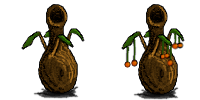History
Vorgons evolved on New Albuquerque, (the original vorgon name for the planet has been lost to time) the lone native life-form that we would consider to be properly intelligent. Early in their prehistory, however, a large cosmic impact left their home-world largely arid, and the species which had evolved to live in a tropical, rain-forest-like habitat had to adapt to deserts and scrubland. Life was hard for the early vorgons, and as a consequence, their strength and stature diminished considerably.
New Albuquerque is a rare planet in that it exists as a habitable world in the midst of a stellar graveyard. Many of the planet’s neighbors are white dwarfs, black holes, or neutron stars. As a result, the region is constantly subject to cosmic storms, and is the site of a remarkably large number of shipwrecks. As a result, the vorgons learned, early in their history, to be scavengers and engineers, using the available cast-off materials to maximum advantage.
About 50,000 years ago, during the height of the 1,000 Years war, a fierce battle was fought on and around New Albuquerque by the Empire of 1,000,000 Suns, and the forces of Troniac. The battle of the three moons left many additional scars on the planet, and saw many vorgons conscripted into the imperial army, or subjected to various genetic engineering experiments. Most of the vorgons who live beyond the confines of New Albuquerque are the descendants of the diaspora from this period. After the war, the Empire made New Albuquerque into a scrap and salvage -yard.
Later, the lost colony ship Garcia’s Hope from the newly-formed Planetary League crash-landed on New Albuquerque, giving it the name that it bears to this day. In the meantime, the descendants of the vorgon exodus were gradually spreading tenuously throughout the galaxy, often serving as engineers aboard the vessels of the Nomad Armies and Breakaway States that cut loose from the Empire of 1,000,000 Suns around the time of the 1,000 Years War.
Biology
Vorgons are carbon- and water- based life-forms, like most in this galaxy. Omnivorous in diet, they still prefer a carnivorous cuisine. In desert environs, though, they will eat basically whatever presents itself. They have two biological sexes, of which, only females posses hair (usually black in color). Vorgons tend to be nocturnal in habit.
Names
Download: Vorgon Name Generator for Windows
“Oh, goody! I jus’ finded this beautiful golden ring jus’ rattlin’ aroun’ out here in the junkyard. Finders keepers!”





